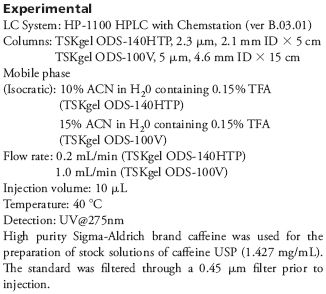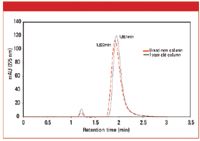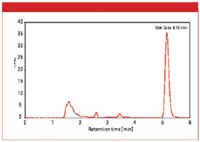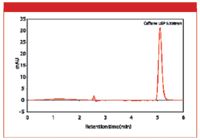High Throughput Reversed Phase HPLC Analysis of Caffeine Using TSK-GEL ODS-140HTP and ODS-100V Columns
High-performance liquid chromatography (HPLC) methods are commonly used for the analysis of caffeine in beverages (1–3).
High-performance liquid chromatography (HPLC) methods are commonly used for the analysis of caffeine in beverages (1–3). Many popular soft drinks have a high percentage of caffeine (1,3,7-trimethylxanthine) as an additive, an alkaloid that occurs naturally in the leaves, seeds, and fruit of tea, coffee, cacao, kola tree, and more than 60 other plants. Because caffeine is a CNS stimulant and can pose health risks for people with certain medical conditions, beverages containing the additive should clearly list the amount they contain.
The Food and Drug Administration (FDA) recommends a maximum caffeine concentration of 65 milligrams per 12-ounce serving of cola beverages, although it does not regulate the caffeine content of these drinks. In 2004, all 25 countries in the European Union (EU) began requiring that packaged drinks with more than 150 mg/L of caffeine be labeled "high caffeine content," followed by the caffeine content expressed in mg/100mL (4). Considering the popularity of soft drinks and the recommendation from the FDA and EU regulatory agencies, an easy and rapid method for the quality control analysis of caffeine in beverages is important.
We report the successful analysis of caffeine utilizing two different TSK-GEL reversed phase columns: a TSKgel ODS-140HTP, 2.3 μm, 2.1 mm i.d. × 5 cm column and a TSKgel ODS-100V, 5 μm, 4.6 mm i.d. × 15 cm column. The 2.3 μm particle size TSK-GEL ODS-140HTP columns were introduced by Tosoh in 2007 to provide a combination of high speed and high resolution, while operating at moderate pressure, thus making these columns compatible with both UPLC® and conventional HPLC equipment. The polylayer C18 bonding chemistry used to prepare these columns results in highly efficient and durable columns. TSK-GEL ODS-100V columns are well suited for the separation of challenging small molecules, including polar compounds such as caffeine, which contain a significant hydrophobic portion.

Results and Discussion
The caffeine USP standard eluted from a TSKgel ODS-140HTP column within two min under isocratic chromatographic conditions using a conventional HPLC system with moderate pressure limits. The durability of the column was tested under these isocratic conditions using a fresh TSKgel ODS-140HTP column and one run frequently for over a year (more than 1000 injections). No significant change in elution profile was noted. Caffeine eluted at 1.922 min from the new column while the used column yielded a retention time of 1.951 min (Figure 1). No significant change was observed in the day-to-day reproducibility (data not shown).

Figure 1: Isocratic elution of caffeine USP and test of column stability using a TSKgel ODS-140HTP, 2.3 μm, 2.1 mm i.d. à 5 cm column.
Caffeine in Diet Coke® was also analyzed without any pre-column treatment using a TSKgel ODS-100V column under isocratic chromatographic conditions as described above (Figure 2). The samples were prepared by dilution with mobile phase, followed by filtration through a 0.45 μm filter prior to injection. The caffeine peak in Diet Coke was separated without any interference from the other ingredients present in the formulation. Caffeine eluted at 5.161 min, which is identical to the caffeine USP standard (Figure 3).

Figure 2: Analysis of caffeine from the other components of Diet Coke using a TSKgel ODS-100V, 5 μm, 4.6 mm i.d. Ã15 cm column.
Both the TSKgel ODS-140HTP and ODS-100V columns offer good resolution and work equally well for the separation of caffeine. If analysis time is of a higher priority and high throughput separation is needed using a conventional HPLC, then the TSKgel ODS-140HTP column is the best choice. If a relatively short analysis time of 5 min is acceptable, the TSKgel ODS-100V is the column to use.

Figure 3: Analysis of caffeine USP standard using a TSKgel ODS-100V, 5 μ m, 4.6 mm i.d. Ã15 cm column.
Conclusions
It is clearly demonstrated that a TSKgel ODS-140HTP reversed phase column can successfully be used with a conventional HPLC system to analyze caffeine with shorter run times and high efficiency. The long-term stability of this column is evident from this study.
A TSKgel ODS-100V column can also be used for the separation of caffeine, offering sharp peaks and high resolution.
References
(1) Tzanavaras PD, Themelis DG, Anal. Chim. Acta581, 89–94 (2007).
(2) Sharma V, Gulati A, Ravindranath SD, and Kumar V, J. Food Comp. Anal.18, 583–594 (2005).
(3) Wang H, Helliwell K, and You X, Food Chem, 68, 115–121 (2000).
(4) Douglass L, Anal. Bioanal. Chem., 389, 231–239 (2007).
Tosoh Bioscience, TSK-GEL and TSKgel are registered trademarks of Tosoh Corporation.
UPLC is a registered trademark of Waters Corporation.
Diet Coke is a registered trademark of The Coca-Cola Company.

Tosoh Bioscience LLC
156 Keystone Drive, Montgomeryville, PA 18936
tel. (215)283-5000, (800)366-4875; fax (215)283-5035
Website: www.tosohbioscience.com
















